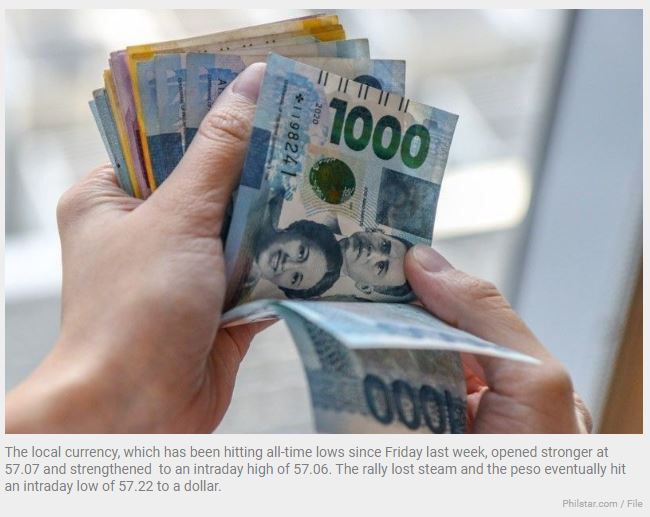Philippines: Peso extends losing streak
MANILA, Philippines — The peso extended yesterday its losing streak to six trading days, slumping to a new record low of 57.18 to $1, 4.5 centavos weaker than Wednesday’s 57.135.
The local currency, which has been hitting all-time lows since Friday last week, opened stronger at 57.07 and strengthened to an intraday high of 57.06. The rally lost steam and the peso eventually hit an intraday low of 57.22 to a dollar.
Investors were spooked because a technical glitch caused the website of the Bankers Association of the Philippines to momentarily display a peso intraday low of 58 to $1, but was eventually corrected to 57.22 to $1.
Traders said the Bangko Sentral ng Pilipinas (BSP) continued to participate in the foreign exchange market to smoothen volatility as volume stayed above $1.15 billion from Wednesday’s $1.23 billion.
Rizal Commercial Banking Corp. chief economist Michael Ricafort attributed the weakness of the peso to the strong dollar amid the hawkish signals from more officials of the United States Federal Reserve.
“The peso was also weaker after the latest hawkish signals from Fed officials as well as the Fed Beige Book Report signaling high prices and tight labor markets weighing on US economic prospects over the next year,” Ricafort said.
The United States central bank has been signaling more rate hikes for a longer period in an effort to tame the inflation.
The economist said the weaker peso could lead to higher inflation and more aggressive rate hikes by the BSP to curb rising inflationary pressures and stabilize the peso exchange rate.
The peso has plunged by 12.1 percent from the end-2021 level of 50.999 to $1.
Meanwhile, Fitch Ratings said the decline in reserves among countries in Asia-Pacific amounting to $590 billion between end-2021 and July this year indicates mounting external financing stress.
“Valuation effects contributed significantly to this trend, as the US currency’s strength has reduced the dollar value of non-US dollar reserve holdings. We believe that some of the decline also reflects moves by certain regional central banks to support their currencies, offsetting depreciation pressures that might otherwise have added to imported inflation,” Fitch said.
The debt watcher said the fall in reserves has been moderate in the Philippines and Indonesia.
According to Fitch, some central banks with more comfortable reserve positions have deployed them to support their currencies.
“We generally do not view the use of reserves to smoothen excessive exchange-rate volatility as challenging creditworthiness. However, should the regional decline in reserves be sustained, this would eventually put downward pressure on ratings for some APAC sovereigns,” Fitch said.
It warned that the risk could be significant where reserves have been a rating strength that offsets other credit weaknesses, such as in the Philippines with a BBB rating and negative outlook.
Source: https://www.philstar.com/business/2022/09/09/2208349/peso-extends-losing-streak


 Thailand
Thailand




